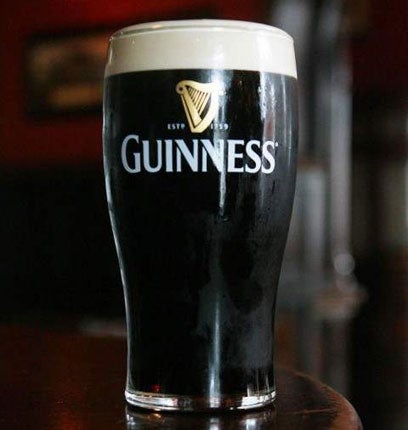Guinness: A campaign that's been brewing for 80 years
Guinness started its journey into advertising almost apologetically, but over the past eight decades it has produced a masterclass in branding. Ian Burrell raises a jar to a true original

The very first Guinness advert, the primary entry in a portfolio of commercial activity that no other brand in the British Isles can match, was revealed to the public gaze exactly 80 years ago this month. And, well, it ain't exactly "Surfer".
It appeared in the columns of the Daily Mail on 6 February 1929 and began with a statement that bordered on an apology: "This is the first advertisement ever issued in a national paper to advertise Guinness." In such times the use of advertising was regarded in some business circles – including by the head of the Guinness family Lord Iveagh – as an act of desperation.
But CJ Newbold, then the Guinness managing director, thought otherwise and engaged the ad agency SH Benson to come up with a campaign. It might not have the visual electricity of Jonathan Glazer's race across a rip curl composed of white stallions but, credit where it's due, Benson's came up with one great line: "Guinness is good for you".
The Guinness archivist Eibhlin Roche unveils the ad in a second floor office in The Storehouse of the famous St James's Gate brewery in Dublin. "They went to a lot of the pubs in London where their offices were based and asked the punters: 'Why are you drinking Guinness?'" she says. "Nine out of ten times the answer back was 'Guinness is good for you'. That's where the slogan came from."
But the real breakthrough for SH Benson came when the agency involved its in-house artist, John M Gilroy, on the Guinness account. Gilroy, a former cartoonist for the Newcastle Evening Chronicle, transformed the Guinness brand, introducing witty and colourful drawings. The Geordie artist was reputedly visiting the circus one day when he was impressed by the sight of a sea lion balancing a ball on his nose. Gilroy, deploying the strange thought processes of great advertising creatives down the decades, conjured the image of a sea lion balancing a bottle of the black stuff and made it the subject of an iconic Guinness poster ad. From there followed a menagerie: an ostrich, a tortoise and then the famous toucan, the best-known Guinness animal.
For 35 years, working alongside the copywriters Ronald Barton and Ronald Bevan, Gilroy and his artwork became synonymous with the Irish stout and slogans such as "Guinness for Strength", "My Goodness, My Guinness" and "A Lovely Day for a Guinness". Gilroy produced more than 100 Guinness press advertisements and more than 50 poster designs.
Gilroy was ahead of his time, even in terms of his consistency in type. "The typography that he used in the Thirties is quite unusual," says Roche. "These were the days before specific brand awareness and here was Gilroy using the same typeface right the way through his adverts."
With Guinness being exported around the world, Gilroy's ads had to appeal to different demographic groups and so one variation of "Guinness for Strength" (showing a flat-capped worker carrying a girder) features an African man holding aloft a log alongside the boast "Guinness gives you power".
That commitment to advertising was reinforced on the first night of commercial television, 21 September 1955, when Guinness used the sea lion promote its product via that medium.
SH Benson's lost the account in 1969 to J Walter Thompson, whose best known campaign, in 1981, featured men who aligned themselves with a mythical "Bottle of Guinness Supporters Club". JWT also paid tribute to Gilroy by bringing the toucan back in film.
After JWT came Allen Brady & Marsh, who produced a campaign based on the concept of the "Guinnless", mocking those who are non-believers in the famous stout. "It wasn't terribly successful," concedes Roche. "It was a dramatic shift away from any of the advertising that had gone before." ABM lost the account after just one year.
Ogilvy & Mather stepped in and made some of the brand's most distinctive campaigns, thinking up the slogan "Pure Genius" and bringing in the Blade Runner actor Rutger Hauer, whose blond crop was a symbol of the foamy head on a pint. O&M's Guinness work gave a nod to Gilroy's quirkiness and love of animals. One ad showed a dolphin in an aquarium, apparently looking through the glass at Hauer sitting in an armchair and nursing a pint. "It's not easy being a dolphin," said the actor.
A 1985 O&M poster, based on the ascent of man and showing an ape evolving by stages into a Guinness drinker, would become the inspiration behind the "Noitulove" television commercial that would win the Cannes Grand Prix 20 years later. Even Glazer's 1999 ad "Surfer", frequently cited as Britain's favourite all-time ad, had its roots in an Irish Guinness ad of 1981 that also featured waves and surfing.
Those last two spots were made by Abbott Mead Vickers, the agency that has held the Guinness account for the past decade, and which developed the line that "Good Things Come to Those Who Wait", to capitalise on the famous two-part pour that marks the drink out from its rivals.
In fact, Guinness, which celebrates its 250th anniversary this year, was brand aware not just before Gilroy but before the state of Ireland itself. The famous O'Neill Harp has adorned the bottles since 1862, but when the Irish Free State came into being in 1922 it wanted to adopt the same symbol. Guinness, which had trademarked the logo in 1876, was having none of it. "The government had to flip their harp the other way round," says Roche. "We always like to say that we got there first."
Join our commenting forum
Join thought-provoking conversations, follow other Independent readers and see their replies
Comments